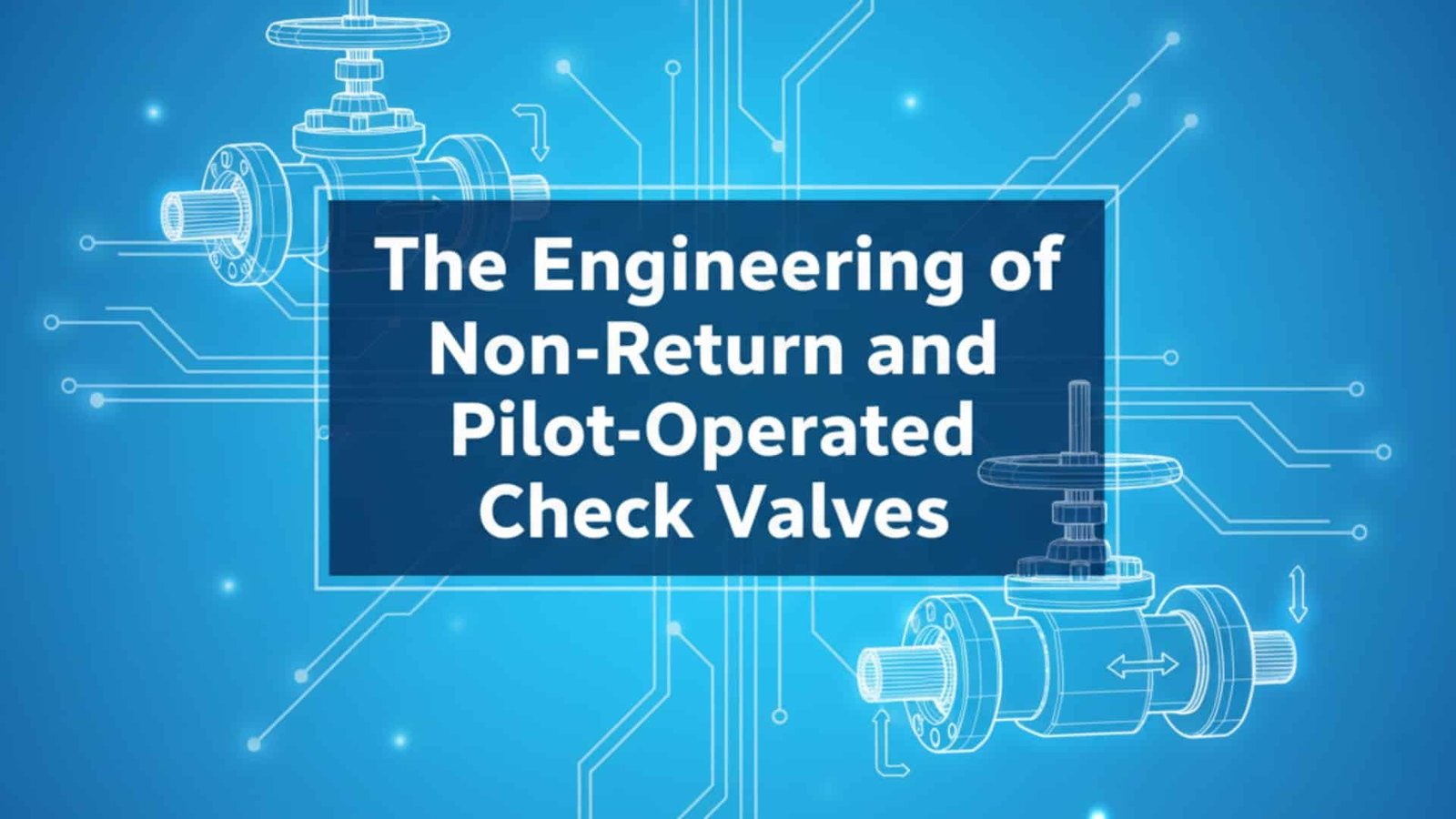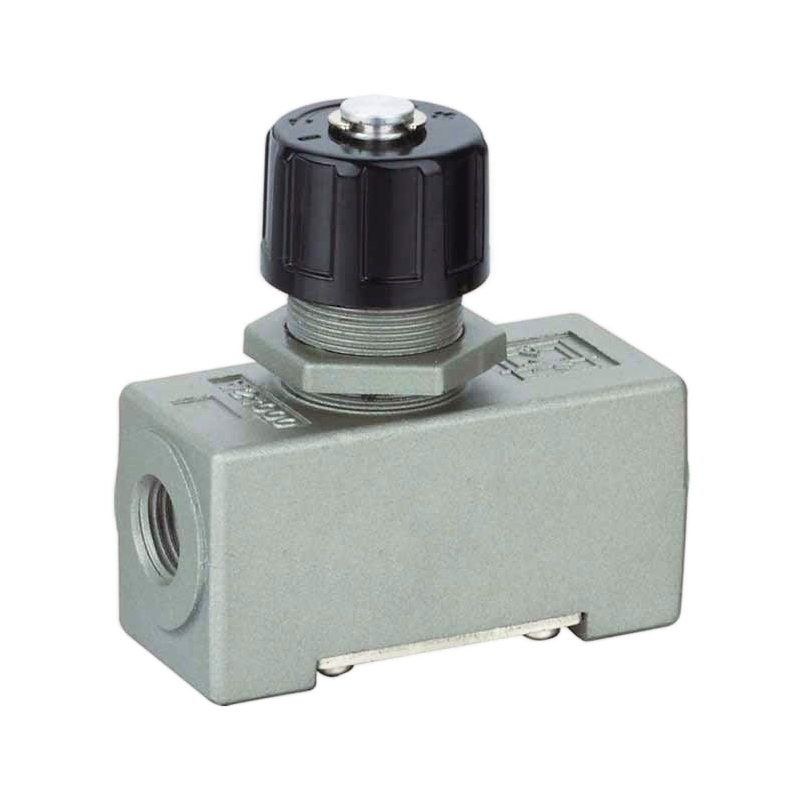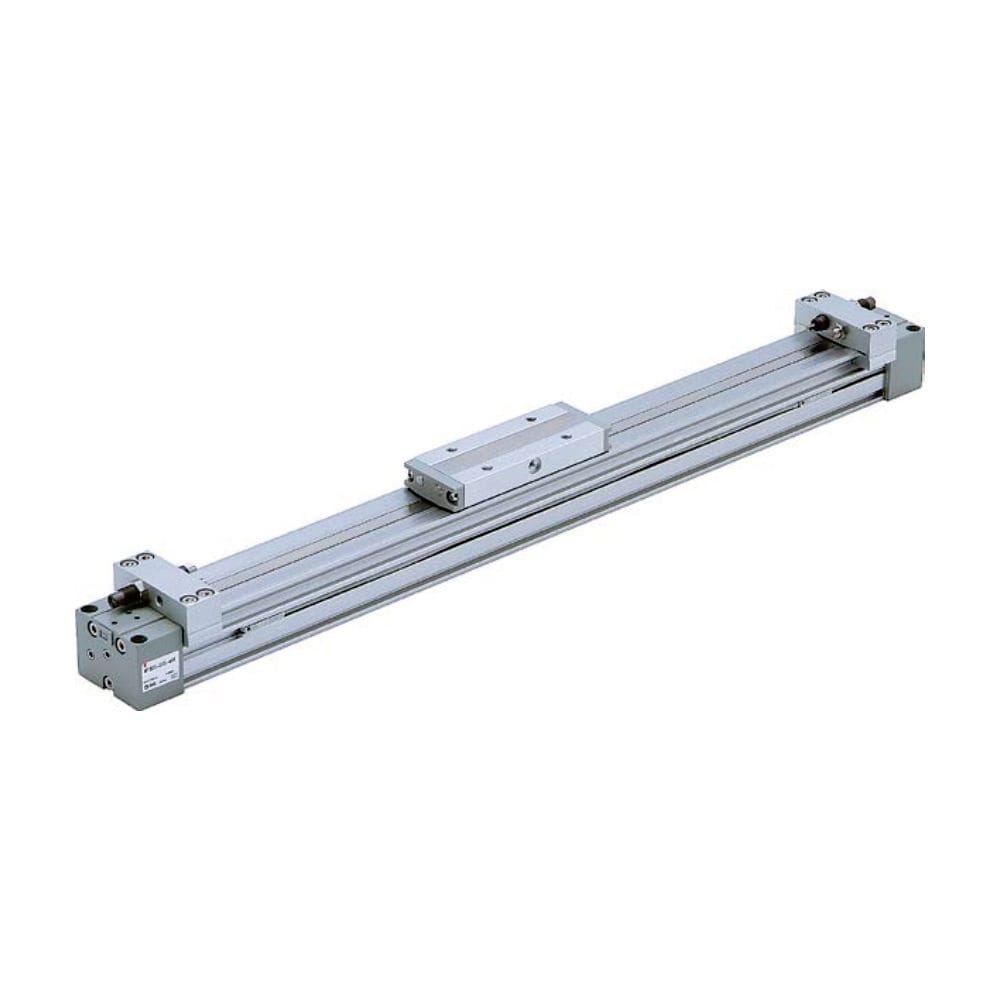Industrial systems face catastrophic failures when fluid flows reverse unexpectedly, causing equipment damage and costly downtime. Traditional check valves often fail under high pressure or create excessive pressure drops that reduce system efficiency. Engineers need reliable solutions that prevent backflow while maintaining optimal performance.
Spätné a pilotné spätné ventily zabezpečujú základnú reguláciu prietoku tým, že zabraňujú spätnému toku prostredníctvom pružinových mechanizmov a pilotom riadených otváracích systémov, čím zabezpečujú bezpečnosť systému, chránia zariadenie pred poškodením a udržiavajú optimálne tlakové podmienky v pneumatických a hydraulických okruhoch.
Last month, I received an urgent call from Marcus, a maintenance engineer at a textile manufacturing plant in North Carolina, whose rodless cylinder system was experiencing severe pressure fluctuations due to inadequate check valve performance. 🏭
Obsah
- What Are the Key Differences Between Non-Return and Pilot-Operated Check Valves?
- How Do You Select the Right Check Valve for Rodless Cylinder Applications?
- What Are the Common Engineering Challenges with Check Valve Design?
- How Do You Troubleshoot Check Valve Performance Issues?
What Are the Key Differences Between Non-Return and Pilot-Operated Check Valves?
Understanding the fundamental differences between these valve types is crucial for selecting the optimal solution for your pneumatic system requirements.
Non-return check valves use spring-loaded mechanisms for automatic flow control, while pilot-operated check valves combine spring operation with external pilot signals for controlled opening, offering greater flexibility and precise flow management in complex pneumatic circuits.
Základné princípy fungovania
Both valve types serve essential functions in pneumatic systems, but their operating mechanisms differ significantly in complexity and control capabilities.
Non-Return Check Valve Operation
- Spring-loaded design: Automatic opening based on tlakový rozdiel1
- Simple mechanism: Minimal moving parts for reliability
- Pressure-activated: Opens when inlet pressure exceeds spring force
- Self-closing: Automatically prevents reverse flow
Pilot-Operated Check Valve Features
- Dual control system: Spring mechanism plus pilot control
- External signal: Pilot pressure overrides spring force
- Controlled opening: Precise timing of valve operation
- Enhanced functionality: Allows reverse flow when needed
Porovnanie výkonu
| Funkcia | Non-Return Check Valve | Pilot-Operated Check Valve |
|---|---|---|
| Opening pressure | 0.5-2 PSI | 0.5-2 PSI (spring only) |
| Control method | Automatic | Manual/automatic |
| Reverse flow | Blocked always | Controllable |
| Zložitosť | Jednoduché | Mierne |
| Náklady | Nižšie | Vyššie |
| Aplikácie | Základná ochrana | Complex circuits |
Design Specifications
Our Bepto check valves feature:
- Hodnoty tlaku: Up to 150 PSI working pressure
- Rozsah teplôt: -20°C to +80°C operating temperature
- Prietoková kapacita: Optimized for rodless cylinder applications
- Material options: Aluminum, stainless steel, and brass bodies
Application Advantages
Non-return check valves excel in:
- Simple protection: Basic backflow prevention
- Aplikácie citlivé na náklady: Budget-friendly solutions
- High-reliability needs: Fewer failure points
- Bezúdržbová prevádzka: No external controls required
Pilot-operated check valves provide:
- Circuit flexibility: Controlled reverse flow capability
- Integrácia systému: Compatible with complex control systems
- Precise operation: Exact timing control
- Advanced functionality: Multiple operating modes
Marcus’s textile plant was experiencing issues with their rodless cylinder positioning system due to inadequate check valve performance. The existing valves were causing:
- Nestabilita tlaku: Fluctuating system pressure
- Posun polohy: Cylinders losing position accuracy
- Energetický odpad: Excessive pressure drops
- Frequent maintenance: Valve failures every 3 months
We recommended our Bepto pilot-operated check valves, which delivered:
- Stable pressure: Consistent system performance
- Presné umiestnenie: Improved cylinder accuracy
- Energetická účinnosť: 20% reduction in air consumption
- Predĺžená životnosť: 18 months without maintenance
The system now operates with exceptional reliability and precision. ⚡
How Do You Select the Right Check Valve for Rodless Cylinder Applications?
Proper valve selection ensures optimal rodless cylinder performance while preventing system damage and maintaining operational efficiency.
Select check valves based on system pressure requirements, flow capacity needs, mounting configuration, and control complexity, considering factors like cracking pressure, flow coefficient, and integration with existing pneumatic circuits to optimize rodless cylinder operation.
Kritické parametre výberu
Several technical factors determine the optimal check valve choice for rodless cylinder applications and system requirements.
Úvahy o tlaku
- Pracovný tlak: Match valve rating to system pressure
- Tlak na praskanie: Minimize pressure drop for efficiency
- Tlakový rozdiel: Consider upstream/downstream conditions
- Bezpečnostná rezerva: 25% above maximum operating pressure
Požiadavky na tok
- Cylinder speed: Flow capacity affects cycle times
- Spotreba vzduchu: Valve sizing impacts efficiency
- Pokles tlaku: Minimize losses for optimal performance
- Prietokový koeficient (Cv)2: Match valve capacity to system needs
Usmernenia pre výber
For Standard Rodless Cylinders
- Bore size 32-63mm: Size 1/8″ to 1/4″ check valves
- Bore size 80-125mm: Size 3/8″ to 1/2″ check valves
- Bore size 160mm+: Size 3/4″ to 1″ check valves
- Vysokorýchlostné aplikácie: Pilot-operated valves recommended
For Precision Applications
- Presnosť polohy: Pilot-operated valves for precise control
- Viacpolohové systémy: Enhanced control capabilities needed
- Aplikácie servopohonov: Low cracking pressure requirements
- Čisté prostredie: Stainless steel construction preferred
Výhody ventilu Bepto
| Typ aplikácie | Odporúčaný ventil | Kľúčové výhody |
|---|---|---|
| Základné polohovanie | Non-return check | Cost-effective, reliable |
| Presné riadenie | Pilotne ovládané | Enhanced accuracy |
| Vysokorýchlostné cykly | Low-pressure check | Minimal flow restriction |
| Drsné prostredie | Nerezová oceľ | Odolnosť proti korózii |
Úvahy o integrácii
- Možnosti montáže: Inline, manifold, or cartridge mounting
- Pripojenia prístavov: Thread types and sizes
- Riadiace rozhrania: Pilot signal requirements
- Prístup k údržbe: Service and replacement ease
System Compatibility
- Existing components: Integration with current valves
- Riadiace systémy: PLC and automation compatibility
- Pressure sources: Pilot supply requirements
- Environmentálne faktory: Temperature and contamination resistance
Sarah, a design engineer from a German automotive parts manufacturer, needed to optimize her rodless cylinder control system for faster production cycles while maintaining positioning accuracy.
Her specific requirements included:
- Cycle time reduction: 30% faster operation needed
- Presnosť polohy: ±0.1mm tolerance required
- Optimalizácia nákladov: Budget constraints for upgrades
- Reliability improvement: Reduce maintenance downtime
Our selection process delivered:
- Optimal valve choice: Pilot-operated check valves selected
- Performance gains: 35% faster cycle times achieved
- Accuracy improvement: ±0.05mm positioning accuracy
- Úspora nákladov: 15% lower total system cost
The optimized system has exceeded all performance targets for 8 months. 🎯
What Are the Common Engineering Challenges with Check Valve Design?
Understanding design challenges helps engineers select appropriate solutions and avoid common pitfalls in check valve applications.
Common engineering challenges include pressure drop optimization, chattering prevention, contamination resistance, and temperature stability, requiring careful material selection, spring design, and flow path engineering to ensure reliable long-term operation in demanding applications.
Design Challenge Analysis
Modern check valve design must address multiple technical challenges while maintaining cost-effectiveness and manufacturing simplicity.
Pressure Drop Minimization
- Flow path design: Streamlined internal geometry
- Valve sizing: Adequate flow area for application
- Spring selection: Minimum force for reliable sealing
- Seat design: Optimized sealing surface geometry
Chattering Prevention
- Damping mechanisms: Controlled valve movement
- Flow stability: Consistent pressure conditions
- Spring characteristics: Proper force/deflection curves
- Valve mass: Optimized moving component weight
Engineering Solutions
Material Selection Challenges
- Odolnosť proti korózii: Suitable materials for environment
- Charakteristiky opotrebenia: Long-term durability requirements
- Teplotná stabilita: Performance across operating range
- Chemická kompatibilita: Resistance to system fluids
Výrobné aspekty
- Tolerance control: Precise dimensional requirements
- Povrchová úprava: Sealing surface quality
- Assembly methods: Consistent manufacturing processes
- Kontrola kvality: Testing and validation procedures
Bepto Design Innovations
| Výzva | Traditional Solution | Bepto Innovation |
|---|---|---|
| Pokles tlaku | Larger valve size | Optimized flow geometry |
| Chattering | Heavy damping | Precision spring design |
| Kontaminácia | Frequent cleaning | Self-cleaning design |
| Teplota | Material limitations | Advanced alloys |
Pokročilé funkcie dizajnu
Our Bepto check valves incorporate:
- Optimized flow paths: Minimal pressure loss design
- Anti-chatter technology: Stable operation across flow ranges
- Odolnosť voči kontaminácii: Self-cleaning valve seats
- Kompenzácia teploty: Stable performance across ranges
Riešenia špecifické pre jednotlivé aplikácie
- Rodless cylinder integration: Optimized for pneumatic systems
- Vysokofrekvenčná prevádzka: Fatigue-resistant designs
- Presné aplikácie: Low-hysteresis characteristics
- Drsné prostredie: Protected internal components
Robert, a project engineer from a Canadian food processing equipment manufacturer, was facing recurring issues with check valve performance in his rodless cylinder systems operating in washdown environments.
His engineering challenges included:
- Contamination issues: Food particles causing valve sticking
- Požiadavky na čistenie: Frequent sanitization needs
- Corrosion problems: Aggressive cleaning chemicals
- Reliability demands: Zero tolerance for production stops
Our engineering solution provided:
- Konštrukcia z nehrdzavejúcej ocele: Complete corrosion resistance
- Self-cleaning design: Contamination-resistant operation
- Sanitary connections: Easy cleaning and maintenance
- Predĺžená životnosť: 2-year maintenance intervals
The system has operated flawlessly through 18 months of demanding service. 💪
How Do You Troubleshoot Check Valve Performance Issues?
Systematic troubleshooting approaches minimize downtime and ensure optimal check valve performance in critical pneumatic applications.
Troubleshoot check valve issues by checking cracking pressure, verifying flow direction, testing pilot signals, and examining contamination levels using proper diagnostic procedures and measurement tools to identify root causes and implement effective solutions.
Common Problem Identification
Understanding typical failure modes enables quick diagnosis and resolution of check valve performance issues.
Performance Symptoms
- Nadmerný pokles tlaku: Flow restriction beyond specifications
- Reverse flow leakage: Inadequate sealing performance
- Pomalá odozva: Delayed opening or closing
- Chattering operation: Unstable valve behavior
Diagnostické postupy
- Tlaková skúška: Verify cracking and sealing pressures
- Meranie prietoku: Check actual vs. rated flow capacity
- Vizuálna kontrola: Examine valve condition and installation
- Analýza systému: Review operating conditions and requirements
Troubleshooting Process
Step 1: Initial Assessment
- Document symptoms: Record all observed issues
- Review history: Check maintenance and operation logs
- Verify installation: Confirm proper mounting and connections
- Bezpečnostné postupy: Implement proper blokovanie/označovanie3
Step 2: Performance Testing
- Cracking pressure test: Verify opening pressure
- Sealing test: Check reverse flow prevention
- Flow capacity test: Measure actual flow rates
- Response time test: Check opening/closing speed
Príručka na riešenie problémov
| Symptóm | Pravdepodobná príčina | Riešenie |
|---|---|---|
| High pressure drop | Undersized valve | Install larger capacity valve |
| Reverse flow | Worn sealing surfaces | Replace valve or sealing elements |
| Pomalá odozva | Kontaminácia | Clean or replace valve |
| Chattering | Improper sizing | Adjust system pressure or valve size |
Preventívna údržba
- Regular inspection: Scheduled performance checks
- Kontrola kontaminácie: Proper filtration systems
- Monitorovanie tlaku: System pressure verification
- Výmena komponentov: Proactive part renewal
Bepto Support Services
We provide comprehensive troubleshooting support:
- Technical assistance: Expert diagnostic support
- Náhradné diely: Fast delivery of genuine components
- Školiace programy: Maintenance staff education
- Optimalizácia systému: Performance improvement recommendations
Jennifer, a maintenance supervisor from a pharmaceutical packaging facility in Switzerland, was experiencing intermittent check valve failures that were disrupting critical production schedules.
Her troubleshooting challenges included:
- Intermittent problems: Difficult to diagnose issues
- Kritické aplikácie: Zero tolerance for failures
- Komplexné systémy: Multiple interacting components
- Dodržiavanie právnych predpisov: FDA validation requirements
Our troubleshooting approach delivered:
- Systematic diagnosis: Comprehensive problem analysis
- Root cause identification: Contamination source located
- Permanent solution: Upgraded filtration system installed
- Podpora validácie: Complete documentation provided
The system has operated without failures for 12 months following our intervention. ⚡
Záver
Proper engineering and selection of non-return and pilot-operated check valves ensures reliable pneumatic system operation, optimal rodless cylinder performance, and long-term cost savings through reduced maintenance and improved efficiency.
FAQs About Check Valves
Q: What is the typical cracking pressure for pneumatic check valves?
Most pneumatic check valves have cracking pressures between 0.5-2 PSI, with low-pressure versions available for sensitive applications requiring minimal pressure drop.
Q: Can pilot-operated check valves work without pilot pressure?
Yes, pilot-operated check valves function as standard check valves when no pilot signal is applied, using only their internal spring mechanism for operation.
Q: How do you prevent check valve chattering in high-flow applications?
Prevent chattering by proper valve sizing, maintaining stable upstream pressure, using appropriate damping, and selecting valves with optimized spring characteristics for your flow range.
Q: What maintenance is required for pneumatic check valves?
Regular inspection for wear, contamination cleaning, pressure testing, and replacement of sealing elements based on operating conditions and manufacturer recommendations.
Q: Are stainless steel check valves worth the extra cost?
Stainless steel valves provide superior corrosion resistance and longer service life in harsh environments, making them cost-effective for demanding applications despite higher initial cost.





